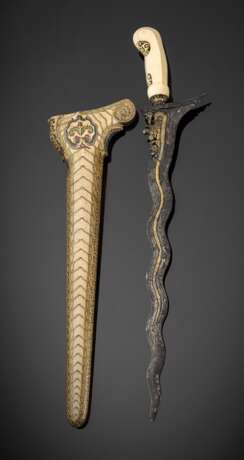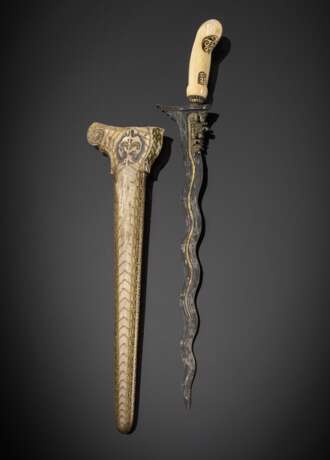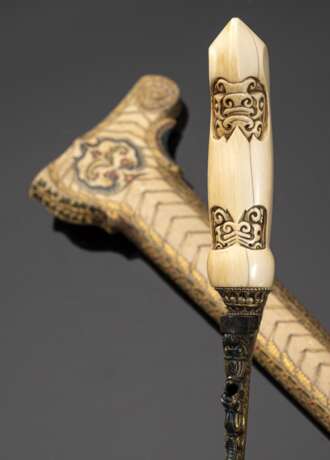ID 1218058
Lot 1541 | Feiner Keris (dhuwing, curiga)
Estimate value
€ 1 800 – 2 500
L. 44,5 cm
Repräsentativer Hof-Keris im Stil von Yogyakarta mit einer Klinge in klassischer nagaraja / nagasasra-Form, mit 11 Wellen. Diese ist dadurch gekennzeichnet, dass die gekrönte Welt-Schlange (Naga Pahóda), welche die Klinge verkörpert, an der Basis erscheint. Darunter ist das unheilabweisende bintulu-Auge zu erkennen, das gleichzeitig den Weltenberg verkörpert. Kala / bintulu steht metaphorisch für den Hochgott Shiva, der für Schöpfung und Zerstörung gleichermaßen steht: Privileg des sakralen Herrschers. Das pamor (Schweissmuster) ist in beras wutah ausgeführt (Lagen in ungesteuerter Schichtung). Die Klinge ist sehr alt (17. Jh. oder älter), die teilvergoldete Schlange ist nachträglich appliziert (gebalan). Der Griff aus Elfenbein ist in planarer nunggak-semi-Form gehalten. Er hat 2 tiefgeschnittene patra (stilisierte Masken), die auf die Durga-Symbolik zurückgehen. Der Keris-Griff stellt in dieser Form eine Verbildlichung des tantrischen shakti-Kults dar, bei der die Verehrung von Shivas shakti Uma / Durga im Mittelpunkt steht. Der tantrisch-vajrayanistische Kult fasste an javanischen Fürstenhöfen im 13. Jh. Fuß und ist unterschwellig bis heute von Bedeutung. Eine andere, ältere Bedeutungsebene liegt in der Darstellung zweier übereinander gestaffelter Gesichter, die möglicherweise noch auf rituelle Kopfjagd in vor-hinduistischer Zeit zurückgehen. Mit feiner Blattgoldauflage und farbigen Applikationen versehene Scheide in sandang walikat-Form, oben mit dem Symbol des Fürstenhauses der Hamengku Buwana von Yogyakarta und zwei symmetrisch angeordneten Weltschlangen als Symbol der sakralen Herrschaft. Das Sultanat Yogyakarta, das zusammen mit Surakarta als eines der beiden Zentren javanischer Kultur gilt, in dem die alten höfischen Traditionen ungebrochen fortwirken, ging 1755 aus dem Reich von Mataram II hervor. Mataram II (Zenith um 1630 unter Sultan Agung Kusuma) hatte seit dem späten 16. Jh. über große Teile Javas geherrscht. Nach 1812 verloren die Fürsten von Surakarta und Yogyakarta einen Teil ihres Gebiets an Britannien. In den Jahren des indonesischen Unabhängigkeitskrieges (1945-1949) wurde die Hauptstadt zeitweise nach Yogyakarta verlegt. Sultan Hamengkubuwono IX. (1912-1988) erklärte sein Reich 1950 zu einem Teil der Indonesischen Republik. Dieser Keris vertritt den Stil des höfischen „Keris gaja Yogyakarta“ in der Tradition nach Hamengku Buwana VIII.
Aus einer alten deutschen Privatsammlung seit den 1950er Jahren gesammelt - Minim. Altersspuren
Lit.: SNKI (Hardi H. et al.2010): Keris Untuk Dunia (Kris for the World). Jakarta - Guritno, H. (2005): Keris Jawa. Jakarta - Hidayat, M. M. (2013): Keris Indonesia. Estetika dan Makna Filosofi. Jakarta.
| Auction house category: | Ethnographic tribal art |
|---|
| Auction house category: | Ethnographic tribal art |
|---|
| Address of auction |
Nagel Auktionen GmbH Neckarstrasse 189 - 191 70190 Stuttgart Germany | ||||||||||||||
|---|---|---|---|---|---|---|---|---|---|---|---|---|---|---|---|
| Preview | |||||||||||||||
| Phone | +49 (0)711 649 690 | ||||||||||||||
| Fax | +49 (0)711 649 69696 | ||||||||||||||
| Buyer Premium | 29,5% | ||||||||||||||
| Conditions of purchase | Conditions of purchase | ||||||||||||||
| Business hours | Business hours
|





